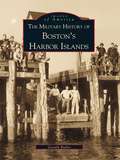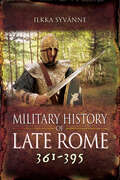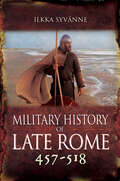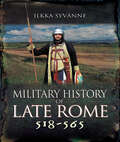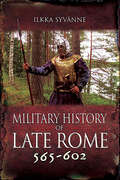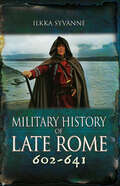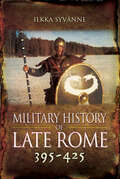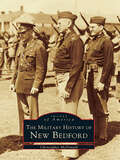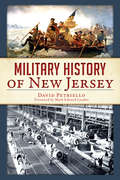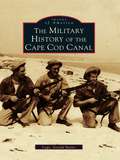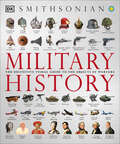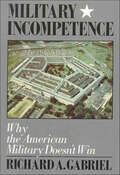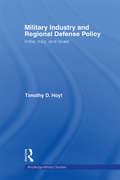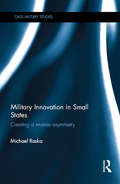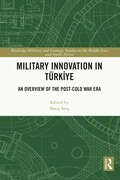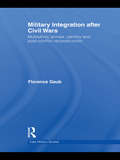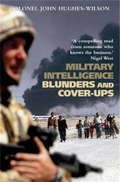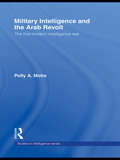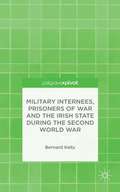- Table View
- List View
Military History Of Ulysses S. Grant From April 1861 To April 1865 Vol. III (Military History Of Ulysses S. Grant From April 1861 To April 1865 #3)
by General Adam BadeauIncludes Civil War Map and Illustrations Pack - 224 battle plans, campaign maps and detailed analyses of actions spanning the entire period of hostilities.Few men can have known General and President of the United States Ulysses S. Grant as well as General Adam Badeau. As Grant's military secretary during 1864-1865, he came to know and work closely with the future president; he wrote his classic account of General Grant's military abilities. Allowed access to documents produced on both the Union and Confederate armies during the war, Badeau weaves these into an excellent narrative. As a soldier himself Badeau is able to give a critical account of the battles actions and motivations that Grant was engaged in.An excellent military biography.
Military History of Boston's Harbor Islands, The (Images of America)
by Gerald ButlerThis accurate pictorial history will acquaint the reader with the seacoast defenses of Boston Harbor. Fortified since the the 1600s, seacoast defenses provided important protection for the new seaport. By the Civil War, strong granite fortresses guarded the seaward approaches to the Port of Boston. Later, powerful long-range guns and mortars protected the seaport. During World War II, the most sophisticated and powerful guns existing were installed. These guns used the first computers and radar systems developed for the military for target acquisition and tracking. In The Military History of Boston's Harbor Islands, great care has been taken to identify harbor defense systems at all of the harbor islands, mainland forts, and the observation and radar towers from Nahant to Scituate. The book identifies and explains the long-abandoned granite and concrete monoliths of Boston Harbor. The Military History of Boston's Harbor Islands brieflydescribes Edgar Allan Poe's tour of duty in Boston Harbor, the impact that Col. Sylvanus Thayer had on Boston's seacoast fortifications, and many mysterious structures at the harbor forts.
Military History of Late Rome 361–395 (Military History Of Late Rome Ser. #2)
by Ilkka SyvänneA comprehensive look at campaigns, battles, and military developments in these dramatic decades.Part of a multivolume history spanning from AD 284-641 that offers detailed accounts of campaigns, battles, and the changes in organization, equipment, strategy, and tactics among both the Roman forces and her enemies in the relevant period, this book covers the tumultuous period from the death of Constantius II in AD 361 to the death of Theodosius. Among the many campaigns covered are the Emperor Julian’s fatal campaign against the Sassanian Persians and the disastrous defeat and death of Valens at Adrianople in 378. Such calamities illustrate the level of external threat Rome’s armies faced on many fronts in this difficult period.Praise for Military History of Late Rome 425–457“An outstanding work . . . [the series] gives us a very good picture of the long process that has come to be known as the ‘Fall of Rome.’ This is an invaluable read for anyone with an interest in Late Antiquity.” — The NYMAS Review
Military History of Late Rome 425–457
by Ilkka SyvänneA history of pivotal military and political events in Ancient Rome from 425 to 457 BC.Military History of Late Rome 425–457 analyses in great detail how the Romans coped with the challenge posed by masses of Huns in a situation in which the Germanic tribes had gained a permanent foothold in the territories of West Rome. This analysis reassesses the strategy and tactics of the period. The book shows how cooperation between the West Roman Master of Soldiers, Aetius, and East Roman Emperor Marcian saved Western civilization from the barbarian nightmare posed by the Huns of Attila. A fresh appraisal of the great clash at the Catalaunian Fields in 451 offers new insights into the mechanics of the fighting and shows that it was a true battle of nations which decided nothing less than the fate of human civilization. Had Aetius and his allies lost the battle and had Marcian not cooperated with Aetius in 451 and 452, we would not have seen the rise of the West and the rise of the scientific thinking.Praise for Military History of Late Rome 425–457“An outstanding work . . . [the series] gives us a very good picture of the long process that has come to be known as the “Fall of Rome”. This is an invaluable read for anyone with an interest in Late Antiquity.” —The NYMAS Review
Military History of Late Rome 457–518
by Ilkka SyvänneA history and military analysis of the world-changing events following the fall of the Western Roman Empire.The Military History of Late Rome 457–518 provides a fresh new look into the events that led to the collapse of West Rome, while East Rome not only survived but went on to prosper despite a series of major defeats that included, most notably, the catastrophic campaign against the Vandals in 468. The author explains what mistakes the West Romans made and what the East Romans did right to survive. He analyzes the role of the barbarian generals and military forces in this and also offers an analysis of the tactical developments during this pivotal period as a result of which the cavalry, so famous from the accounts of Procopius, became the dominant arm in the East. The book also offers a detailed study of a number of battles that have never before been subjected to such scrutiny, and puts these firmly into the context of their times. At the very end of this period in 518, East Rome was poised to start its reconquest under Anastasius’ successors Justin I and Justinian I. This book explains why this was possible.
Military History of Late Rome 518–565
by Ilkka Syvänne&“An outstanding work . . . [the series] gives us a very good picture of the long process that has come to be known as the &‘Fall of Rome.&’&” —The NYMAS Review The Military History of Late Rome 518-565 provides a new, fresh analysis of the revival of Roman fortunes during the reigns of Justin I (518–527) and Justinian I (527–565). The book narrates in great detail the re-conquests of North Africa, Italy and southern Spain by Justinian&’s armies. It also explores the massive encounters between the Romans and Persians in the east, and the apocalyptic fights in the Balkans between the Romans and barbarians. The author pays particular attention to the tactics and battles so there is detailed analysis of all of the period engagements, such as Dara, Satala, Callinicum, Ad Decimum, Tricamarum, Rome, Scalae Veteres, Antonia Castra, Gallica, Campi Catonis, Hippis River, Busta Gallorum, Mons Lactarius, Casilinum, Archaeopolis, Phasis, and others. The narrative features the military exploits of the great Roman heroes, such as Belisarius and Narses, while not forgetting the many other overlooked generals such as Germanus, Mundus, John the nephew of Vitalian, Martinus, Dagistheus and Sittas, not to mention the dashing hero John Troglita whose achievements were immortalized by the Roman epic poet Corippus.
Military History of Late Rome 565–602
by Ilkka SyvänneMilitary History of Late Rome 565-602 provides a new fresh analysis of the Roman Empire in the aftermath of the reconquests of Justinian I (527-65). It is often claimed that Justinian overstretched the Roman resources, but this analysis proves that view wrong. It demonstrates that the initial troubles were largely the result of the mistakes of Justin II (565-78) and that his successors, Tiberius II (578-82) and Maurice (582-602), not only restored its fortunes but were, at the time of the death of Maurice, actually poised to complete the reconquests of Justinian. It was thanks to the reforms of Maurice, which were codified in the military treatise the Strategikon, that the Roman army had achieved a position of relative superiority over all of its enemies so that by 602 the Romans had decisively defeated the Persians, Slavs and Avars and were poised to complete the project of reconquest. These gains, however, were lost when Maurice was murdered in a military mutiny which brought Phocas to power. This volume explains why the Roman army overthrew one of the greatest Roman emperors who ever lived. This was an era of epic battles so it is not a surprise that the author also pays particular attention to the period tactics and analyses all of the period battles in great detail. These include for example such battles as Melitene, Constantia, Sirmium, Nymphius River, Solanchon, Lake Urmiah, Plain of Canzak, Iatrus, and the epic battles of Priscus and Comentiolus in the Balkans.
Military History of Late Rome 602–641
by Ilkka SyvänneThe Military History of Late Rome 565-602 provides a fresh analysis of the Roman Empire from the reign of Phocas (602-10) until the death of Heraclius (610-41). This was an era of unprecedented upheavals which is usually considered to have resulted in the end of antiquity. The usurpations of Phocas and Heraclius led to the collapse of the Roman defenses; The Persians conquered Syria, Lebanon, Palestine and Egypt; The Avars and Slavs ravaged the Balkans; The Lombards held the upper hand in Italy; the Visigoths conquered Spain; But then happened one of the most remarkable reversals of fortune in the history of mankind. Heraclius began his holy war against the fire-worshippers. He launched a very effective counterattack against the Persians as a result of which the Romans not only defeated the Persians but actually even extended their domains at their expense, and not only this, because by 633 Heraclius was already restoring the Roman fortunes in the Balkans. This volume revises many of the previously held views of how this took place and what actually happened. The Roman armies seemed invincible and then happened yet another great reversal of fortune – the Muslims began their jihad to conquer the world. The author provides a fresh analysis of all of these upheavals; explains in detail why these reversals of fortune happened; what enabled the Romans to defeat the Persians; and why the Romans lost when they fought against the Muslims and, conversely, why the Muslims were so successful. This was an era of epic campaigns and battles all of which are explained in unprecedented detail. The epic campaigns needed equally talented commanders who include, for example, Heraclius, Chosroes II Parwez, Shahrbaraz, Shahin, Abu Bakr, Umar, Abu Ubaydah, and Khalid b. al-Walid, the Sword of Allah.
Military History of Late Rome, 395–425
by Ilkka SyvänneA detailed overview of the tumultuous events of this pivotal period, in which a divided Rome was plagued by assassination, civil wars, and invading hordes.This ambitious series offers a comprehensive narrative of late Roman military history from 284–641. Each volume gives a detailed account of the changes in organization, equipment, strategy, and tactics among both the Roman forces and their enemies in the relevant period, while also giving a detailed but accessible account of the campaigns and battles.This third volume analyzes in great detail the pivotal years of 395–425. It was then that the mighty Roman Empire faced the Great Migrations while being wracked by civil wars. In 395 the task of defending the Roman Empire fell on the great generalissimo Stilicho. He faced a series of hostile bureaucrats, emperors, usurpers, and foreign foes until he was killed in a conspiracy in 409. His death led to an event that shook up the Empire to its very core. The city of Rome fell to the Visigoths of Alaric in 410. The book shows why this happened and how and why the Germanic tribes were able to settle inside the borders of the Empire. This, however, is not the entire picture. In contrast to the West Romans, the East Romans survived the civil wars and faced the Germans, Huns, and Persia successfully. Why it was so and why were the East Romans able to take control also of West Rome in 425? The information in this book will give history buffs much to consider and debate.Praise for Military History of Late Rome 425–457“An outstanding work . . . [the series] gives us a very good picture of the long process that has come to be known as the ‘Fall of Rome.’ This is an invaluable read for anyone with an interest in Late Antiquity.” —The NYMAS Review
Military History of New Bedford, The (Images of America)
by Christopher McdonaldThis accurate and exciting pictorial history will acquaint the reader with the seacoast defense of New Bedford. Fortified since the 1700s, seacoast defenses provided important protection for the New Bedford area. By the time of the Civil War, a strong granite fortress was under construction to guard the seaward approaches to the harbor of New Bedford and, later, powerful long-range guns were installed to protect the seaport. In The Military History of New Bedford, great care has been taken to identify more than two hundred vintage photographs of the harbor defense systems at all the points of Buzzards Bay, coastal fortifications, and the observation and radar towers from the Cape Cod Canal to Westport. The book identifies and explains the long-abandoned granite and concrete monoliths of New Bedford. It touches upon Gen. Robert E. Lee's role in the construction of the granite fort at Clark's Point (Fort Taber) and describes the impact that Henry Martyn Robert had in the area by writing Pocket Manual of Rules of Order for Deliberative Assemblies, later known as Robert's Rules of Order.
Military History of New Jersey (Military)
by Mark Edward Lender David PetrielloWar came to Garden State soil early. The Dutch fought the Indians in Kieft's War, while the English fought the Spanish in the War of Jenkins' Ear and the French, Swedes and native nations in dozens of other conflicts. New Jersey played an integral role as the "Crossroads of the American Revolution." The Battle of Trenton, the crossing of the Delaware and battles at Monmouth and Springfield helped the colonies break free from Britain. During both world wars, German submarines lurked along the coastline. Historian David Petriello presents a comprehensive military history of New Jersey, highlighting the state's major and lesser-known engagements and contributions to the defense of the nation.
Military History of the Cape Cod Canal, The (Images of America)
by Capt. Gerald ButlerDuring World War II, with Allied merchant and navy ships under the threat of German U-boats, the eastern seaboard was on high alert. The Cape Cod Canal, a vital waterway for commercial and military traffic, underwent a period of strict control, occupation, and defense. This pictorial history documents the activity during that time and the extensive array of weaponry and manpower brought to bear in coastal defense.In The Military History of the Cape Cod Canal, the abandoned foundations at Sagamore Hill and throughout most of Buzzards Bay are explored, as well as the weapons, devices, and personnel assigned to ensure the canal's integrity throughout the war. Although the responsibilities of the U.S. Army's Coast Artillery are a focal point, the actions of the U.S. Navy, the U.S. Coast Guard, and the air arms of all the military services during World War II are also included. The Military History of the Cape Cod Canal documents the mishaps, collisions, and war-damaged ships in and near the canal, as well as the joint military protection forces and plans in effect during World War II.
Military History: The Definitive Visual Guide to the Objects of Warfare (DK Definitive Visual Histories)
by DKThe world&’s weaponry is showcased inside this spectacular visual guide. From the spears and swords of ancient times to the guns and grenades of modern warfare, 5,000 years of weaponry are explored and explained in unprecedented detail. Military History profiles key arms and armaments and conveys technologies and tactics across hundreds of pages of dramatic photography and accessible text. Find out how war is waged between battleships at sea, tanks on the battlefield, and fighter planes in the skies. Climb siege towers, drive chariots, enter medieval fortresses, fly unmanned drones, and detect stealth bombers. You will also experience virtual tours of iconic vehicles, including the T-34 Tank, the Lockheed F-117 Stealth Bomber, and the AH-64 Apache helicopter. And discover the leaders, battles, and weapons of war that have changed the course of history, and understand the lasting impact of global conflicts.This complete history of weaponry is essential reading for military enthusiasts of all ages.
Military Honour and the Conduct of War: From Ancient Greece to Iraq (Cass Military Studies)
by Paul RobinsonThis study presents the first examination of the influence of ideas of honour on the causes, conduct and ending of wars from Ancient Greece to the present day. Paul Robinson begins with a theoretical examination of the concept of honour, to clearly explain the many contradictions and tensions inherent within honour systems. He then shows how honour has often contradictory and paradoxical effects on the conduct of war and illustrates this through seven case studies: Classical Greece; Ancient Rome; mediaeval Chivalry; Elizabethan England; the American Civil War; the British Empire; and the Western world after World War II (including the Vietnam War and the current conflict in Iraq). Key topics covered include: honour and virtue honour and the causes of war honour as a motivation for fighting honours and rewards death and honour honour and the conduct of war honour and the enemy honour and the ending of wars women and honour This book reveals that the often contradictory behaviour of soldiers during war is a product of the contradictions inherent in the concept of honour.This book will be of great interest to all students of military ethics, military history, politics, international relations, anthropology, sociology, philosophy and the history of ideas.
Military Incompetence: Why the American Military Doesn't Win (American Century)
by Richard A. GabrielFormer soldier and author Richard Gabriel offers a prescription for reform based on his twenty years of military experience. The history of American military operations in the post-Vietnam era has been marked by failure and near-disaster. Since 1970, American forces have been committed in five operations--in Sontay to rescue prisoners, in Cambodia on behalf of the crew of the Mayaguez, in Iran to rescue the American hostages, in Beirut, and in Grenada--and in each case they have failed. Gabriel tells how and why each was crippled by faulty intelligence, clumsy execution, or poor planning by the Joint Chiefs of Staff. Much of his information is still classified by the Pentagon and is revealed here for the first time.
Military Industry and Regional Defense Policy: India, Iraq and Israel (Cass Military Studies)
by Timothy D. HoytMilitary Industry and Regional Defense Policy re-examines military industrialization in the developing world, focusing on policy-making in producer states and the impact of security perceptions on such policy-making. Timothy D. Hoyt reassesses the role of regional state sub-systems in international relations, and recent historical studies of international technology and arms transfers. Looking at Israel, Iraq and India, the three most powerful regional powers in the Cold War era, he presesnts an expert analysis of the three-sided phenomena of the regional hegemony, the regional competitor and the small over-achiever. This new book breaks away from existing literature on military industries in the developing world, which has focused on their economic and development costs and benefits. These past studies have used primitive methodologies that focus on the production of complete weapons systems - a misleading gauge in a world of growing international defense cooperation. They have also ignored empirical evidence of the impact of local military industrial production on Cold War regional conflict, and of the defence planning and concerns that drove development of indigenous military industries in key regional powers. This new text delivers an incisive new perspective.
Military Industry and Regional Defense Policy: India, Iraq and Israel (Cass Military Studies)
by Timothy D. HoytMilitary Industry and Regional Defense Policy re-examines military industrialization in the developing world, focusing on policy-making in producer states and the impact of security perceptions on such policy-making.Timothy D. Hoyt reassesses the role of regional state sub-systems in international relations, and recent historical studies of international technology and arms transfers. Looking at Israel, Iraq and India, the three most powerful regional powers in the Cold War era, he presesnts an expert analysis of the three-sided phenomena of the regional hegemony, the regional competitor and the small over-achiever.This new book breaks away from existing literature on military industries in the developing world, which has focused on their economic and development costs and benefits. These past studies have used primitive methodologies that focus on the production of complete weapons systems - a misleading gauge in a world of growing international defense cooperation. They have also ignored empirical evidence of the impact of local military industrial production on Cold War regional conflict, and of the defence planning and concerns that drove development of indigenous military industries in key regional powers. This new text delivers an incisive new perspective.
Military Innovation in Small States: Creating a Reverse Asymmetry (Cass Military Studies)
by Michael RaskaThis book provides a comprehensive assessment of the global diffusion of the Revolution in Military Affairs (RMA) and its impact on military innovation trajectories in small states. Although the 'Revolution in Military Affairs' (RMA) concept has enjoyed significant academic attention, the varying paths and patterns of military innovation in divergent strategic settings have been overlooked. This book seeks to rectify this gap by addressing the broad puzzle of how the global diffusion of RMA-oriented military innovation – the process of international transmission, communication, and interaction of RMA-related military concepts, organizations, and technologies - has shaped the paths, patterns, and scope of military innovation of selected small states. In a reverse mode, how have selected small states influenced the conceptualization and transmission of the RMA theory, processes, and debate? Using Israel, Singapore and South Korea as case studies, this book argues that RMA-oriented military innovation paths in small states indicate predominantly evolutionary trajectory, albeit with a varying patterns resulting from the confluence of three sets of variables: (1) the level of strategic, organizational, and operational adaptability in responding to shifts in the geostrategic and regional security environment; (2) the ability to identify, anticipate, exploit, and sustain niche military innovation – select conceptual, organizational, and technological innovation intended to enhance the military’s ability to prepare for, fight, and win wars, and (3) strategic culture. While the book represents relevant empirical cases for testing the validity of the RMA diffusion hypotheses, from a policy-oriented perspective, this book argues that these case studies offer lessons learned in coping with the security and defence management challenges posed by military innovation in general. This book will be of much interest for students of military innovation, strategic studies, defence studies, Asian politics, Middle Eastern politics and security studies in general.
Military Innovation in The Interwar Period
by Williamson Murray Allan R. MillettIn 1914, the armies and navies that faced each other were alike right down to the strengths of their companies and battalions and the designs of their battleships and cruisers. Differences were of degree rather than essence. During the interwar period, however, the armed forces grew increasingly asymmetrical, developing different approaches to the same problems. This 1996 study of major military innovations in the 1920s and 1930s explores differences in exploitation by the seven major military powers. The comparative essays investigate how and why innovation occurred or did not occur, and explain much of the strategic and operative performance of the Axis and Allies in World War II. The essays focus on several instances of how military services developed new technology and weapons and incorporated them into their doctrine, organisation and styles of operations.
Military Innovation in Türkiye: An Overview of the Post-Cold War Era (Routledge Military and Strategic Studies on the Middle East and North Africa)
by Barış AteşThis book explores Turkish military innovation since the Cold War. The major questions addressed are how Türkiye has been able to innovate, the production of new weapon systems, its philosophical background, how the country overcame bureaucratic and economic obstacles, and how these innovations resonated in military doctrine and organization. Focusing on two main defense industry projects that trigger an overall change in the military doctrine and organization, the text examines the innovative inclinations of the Turkish military realm and reveals the societal, economic and political consequences of military innovation. This book fills a gap in the literature by providing an interdisciplinary and comprehensive overview of Turkish military innovation. Contributors include those involved in and affected by the military innovation process, as well as scholars who monitor the process using primary sources. Military Innovation in Türkiye will appeal to academics, politicians and military professionals interested in understanding the evolution of the Turkish military.
Military Integration after Civil Wars: Multiethnic Armies, Identity and Post-Conflict Reconstruction (Cass Military Studies)
by Florence GaubThis book examines the role of multiethnic armies in post-conflict reconstruction, and demonstrates how they can promote peacebuilding efforts. The author challenges the assumption that multiethnic composition leads to weakness of the military, and shows how a multiethnic army is frequently the impetus for peacemaking in multiethnic societies. Three case studies (Nigeria, Lebanon and Bosnia-Herzegovina) determine that rather than external factors, it is the internal structures that make or break the military institution in a socially challenging environment. The book finds that where the political will is present, the multiethnic military can become a symbol of reconciliation and coexistence. Furthermore, it shows that the military as a professional identity can supersede ethnic considerations and thus facilitates cooperation within the armed forces despite a hostile post-conflict setting. In this, the book challenges widespread theories about ethnic identities and puts professional identities on an equal footing with them. The book will be of great interest to students of military studies, ethnic conflict, conflict studies and peacebuilding, and IR in general Florence Gaub is a Researcher and Lecturer at the NATO Defence College in Rome. She holds a PhD in International Politics from Humboldt University, Berlin.
Military Intelligence Blunders and Cover-Ups: New Revised Edition
by Colonel John Hughes-WilsonThis book is a professional military-intelligence officer's and a controversial insider's view of some of the greatest intelligence blunders of recent history. It includes the serious developments in government misuse of intelligence in the recent war with Iraq. Colonel John Hughes-Wilson analyses not just the events that conspire to cause disaster, but why crucial intelligence is so often ignored, misunderstood or spun by politicians and seasoned generals alike. This book analyses: how Hitler's intelligence staff misled him in a bid to outfox their Nazi Party rivals; the bureaucratic bungling behind Pearl Harbor; how in-fighting within American intelligence ensured they were taken off guard by the Viet Cong's 1968 Tet Offensive; how over confidence, political interference and deception facilitated Egypt and Syria's 1973 surprise attack on Israel; why a handful of marines and a London taxicab were all Britain had to defend the Falklands; the mistaken intelligence that allowed Saddam Hussein to remain in power until the second Iraq War of 2003; the truth behind the US failure to run a terrorist warning system before the 9/11 WTC bombing; and how governments are increasingly pressurising intelligence agencies to 'spin' the party-political line.
Military Intelligence Blunders and Cover-Ups: New Revised Edition
by John Hughes-WilsonThis book is a professional military-intelligence officer's and a controversial insider's view of some of the greatest intelligence blunders of recent history. It includes the serious developments in government misuse of intelligence in the recent war with Iraq. Colonel John Hughes-Wilson analyses not just the events that conspire to cause disaster, but why crucial intelligence is so often ignored, misunderstood or spun by politicians and seasoned generals alike. This book analyses: how Hitler's intelligence staff misled him in a bid to outfox their Nazi Party rivals; the bureaucratic bungling behind Pearl Harbor; how in-fighting within American intelligence ensured they were taken off guard by the Viet Cong's 1968 Tet Offensive; how over confidence, political interference and deception facilitated Egypt and Syria's 1973 surprise attack on Israel; why a handful of marines and a London taxicab were all Britain had to defend the Falklands; the mistaken intelligence that allowed Saddam Hussein to remain in power until the second Iraq War of 2003; the truth behind the US failure to run a terrorist warning system before the 9/11 WTC bombing; and how governments are increasingly pressurising intelligence agencies to 'spin' the party-political line.
Military Intelligence and the Arab Revolt: The First Modern Intelligence War (Studies in Intelligence)
by Polly A. MohsMilitary Intelligence and the Arab Revolt examines the use and exploitation of intelligence in formulating Britain’s strategy for the Arab Revolt during the First World War. It also presents a radical re-examination of the achievements of T.E. Lawrence (Lawrence of Arabia) as an intelligence officer and guerrilla leader. Modern intelligence techniques such as Sigint, Imint and Humint were incorporated into strategic planning with greater expertise and consistency in Arabia than in any other theatre during the war, and their deployment as tactical support for the Arab forces was decisive. Using much previously unpublished material, this study shows conclusively how Britain’s intelligence community in Arabia influenced the conduct of the Arab campaign, promoted a full-scale guerrilla war and thereby facilitated the Arab armies’ march north into Syria, Palestine and the modern Middle East. Polly A. Mohs contributes to the unveiling of another hidden corner of the history of the Middle East and to a better understanding of the significance of intelligence in formulating strategic processes in the modern era. Military Intelligence and the Arab Revolt will be of much interest to students of intelligence studies, military history, Middle East history, British imperial history, guerrilla warfare and insurgency.
Military Internees, Prisoners of War and the Irish State during the Second World War
by Bernard KellyBetween 1939 and 1945, over two hundred German and forty-five Allied servicemen were interned in neutral Ireland. They presented a series of extremely complex issues for the de Valera government, which strove to balance Ireland's international relationships with its obligations as a neutral.

